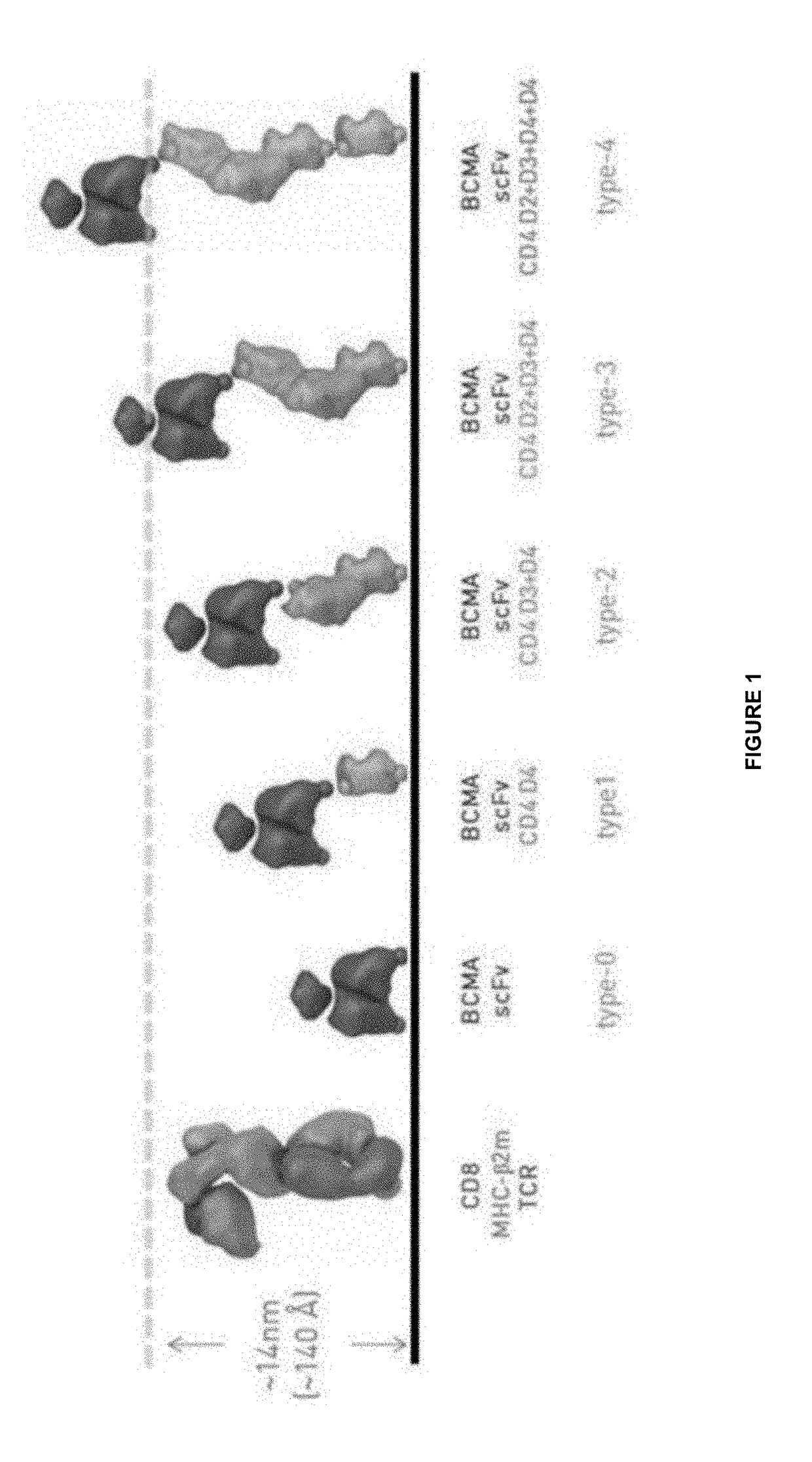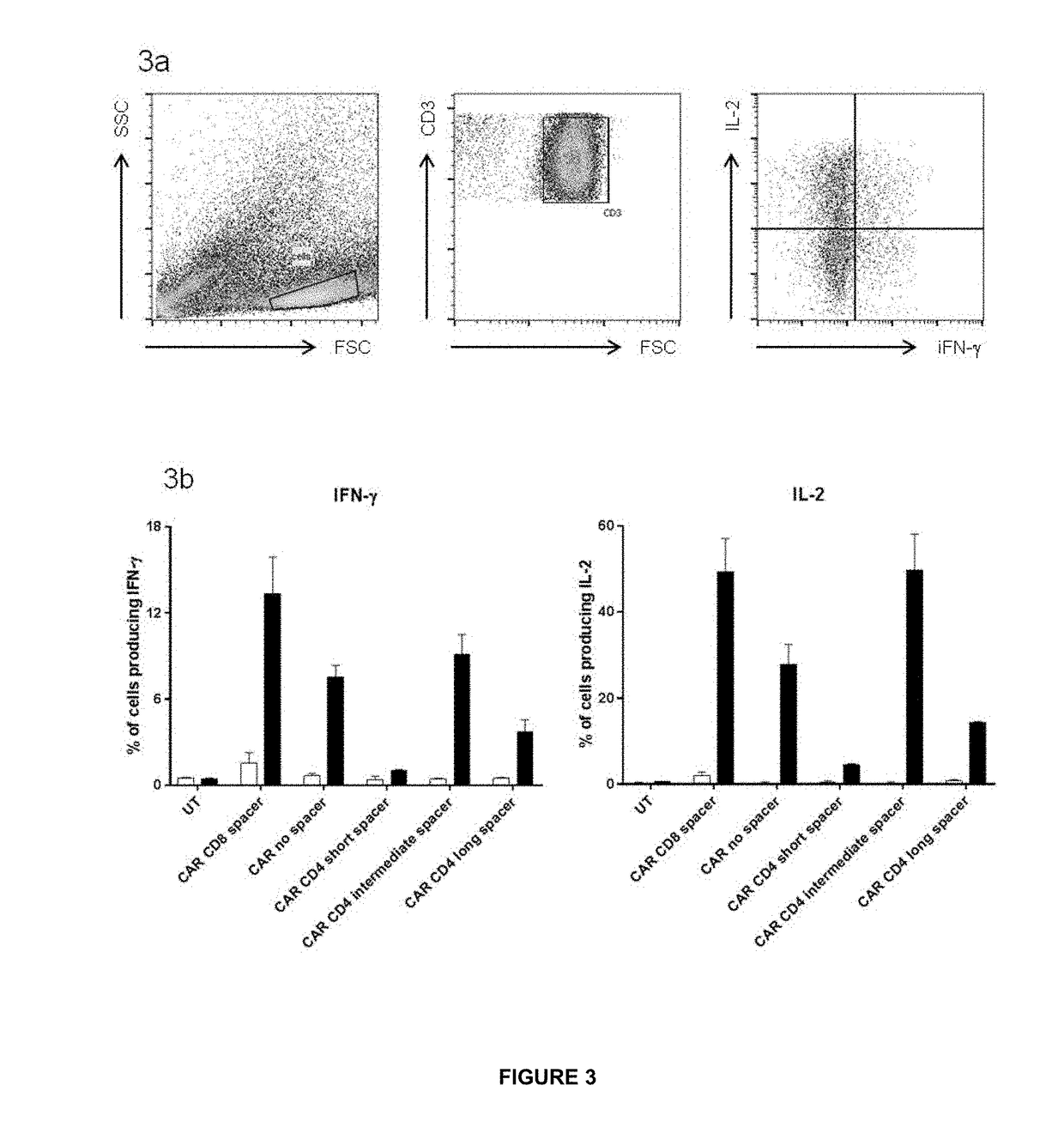Novel chimeric antigen receptors
a technology of chimeric antigen and receptor, applied in the field of chimeric antigen receptor, can solve the problems of inability to provide prolonged expansion and antitumor activity in vivo
- Summary
- Abstract
- Description
- Claims
- Application Information
AI Technical Summary
Benefits of technology
Problems solved by technology
Method used
Image
Examples
example 1
ion of CAR (Chimeric Antigen Receptor) Containing Different Extracellular Linker Length
[0121]The generic CAR architecture investigated here comprises the target-specific scFv, variable length CD4 spacers (SEQ ID NOs: 2, 3 and 4), CD4 transmembrane domain (SEQ ID NO: 5), CD28 intracellular domain (SEQ ID NO: 6) and CD3zeta (CD3ζ) signaling domain (SEQ ID NO: 7).
[0122]The entire CAR construct is constructed allowing for the insertion of different CD4 spacer domains (SEQ ID NOs: 2, 3 and 4) as synthesised DNA-fragments by incorporating appropriate restriction sites in the CAR and DNA sequences. Standard molecular biology protocols are followed to PCR amplify, restriction enzyme digest, purify and ligate DNA fragments into expression vectors.
TABLE 1Details of sequences used in CAR constructSEQ IDNO.DescriptionSequence2CD4 Domain 4RATQLQKNLTCEVWGPTSPKLMLSLKLENKEAKVSKREKAVWVLNPEAGMWQCLLSDSGQVLLESNIKVLP3CD4 Domain 3LAFQKASSIVYKKEGEQVEFSFPLAFTand Domain 4VEKLTGSGELWWQAERASSSKSWITFDLKNKEVSVK...
example 2
ion of Antigen Binding of scFv Using SPR / BIAcore
[0123]Soluble scFv fragments produced and purified from mammalian expression systems are subjected to in vitro affinity determination to their antigen. A dilution series of scFv protein in HBS-EP buffer is injected over a BIAcore T200 chip surface previously coated with the antigen at an appropriate ‘Response Unit Density’ and the sensogram recorded. Analysis of the binding kinetics is assisted by the proprietary software using an appropriate fitting model (mostly 1:1 binding). Affinity data can be used to confirm suitability of scFv fragments to be used in the CAR construct.
example 3
n of CAR on T-Cells
[0124]In brief, host T cells are transfected or transduced with the appropriate CAR construct using standard protocols known in the art. Mammalian expression vectors may be used for transient cell surface expression or retroviral vector transduction may be used for stably inserted CARs.
PUM
| Property | Measurement | Unit |
|---|---|---|
| distance | aaaaa | aaaaa |
| size | aaaaa | aaaaa |
| binding affinity | aaaaa | aaaaa |
Abstract
Description
Claims
Application Information
 Login to View More
Login to View More - R&D
- Intellectual Property
- Life Sciences
- Materials
- Tech Scout
- Unparalleled Data Quality
- Higher Quality Content
- 60% Fewer Hallucinations
Browse by: Latest US Patents, China's latest patents, Technical Efficacy Thesaurus, Application Domain, Technology Topic, Popular Technical Reports.
© 2025 PatSnap. All rights reserved.Legal|Privacy policy|Modern Slavery Act Transparency Statement|Sitemap|About US| Contact US: help@patsnap.com



